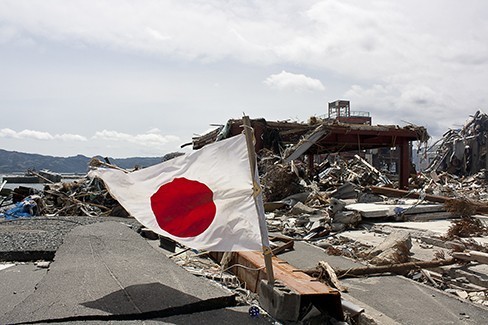
Devastation of the earthquake which happened on March 11, 2011 in Honshu, Japan. (credit: Daniel Pierce)
In [latex]2010[/latex], a major earthquake struck Haiti, destroying or damaging over [latex]285,000[/latex] homes.[1] One year later, another, stronger earthquake devastated Honshu, Japan, destroying or damaging over [latex]332,000[/latex] buildings,[2] like those shown in the picture above. Even though both caused substantial damage, the earthquake in [latex]2011[/latex] was [latex]100[/latex] times stronger than the earthquake in Haiti. How do we know? The magnitudes of earthquakes are measured on a scale known as the Richter Scale. The Haitian earthquake registered a [latex]7.0[/latex] on the Richter Scale[3] whereas the Japanese earthquake registered a [latex]9.0[/latex].[4]
The Richter Scale is a base-ten logarithmic scale. In other words, an earthquake of magnitude 8 is not twice as great as an earthquake of magnitude [latex]4[/latex]. It is [latex]{10}^{8 - 4}={10}^{4}=10,000[/latex] times as great! In this lesson, we will investigate the nature of the Richter Scale and the base-ten function upon which it depends.
Candela Citations
- Outcomes. Provided by: Lumen Learning. License: CC BY: Attribution
- College Algebra. Authored by: Abramson, Jay, et al.. Located at: http://cnx.org/contents/fd53eae1-fa23-47c7-bb1b-972349835c3c@5.175. License: CC BY: Attribution
- http://earthquake.usgs.gov/earthquakes/eqinthenews/2010/us2010rja6/#summary. Accessed [latex]3/4/2013[/latex]. ↵
- http://earthquake.usgs.gov/earthquakes/eqinthenews/2011/usc0001xgp/#summary. Accessed [latex]3/4/2013[/latex]. ↵
- http://earthquake.usgs.gov/earthquakes/eqinthenews/2010/us2010rja6/. Accessed [latex]3/4/2013[/latex]. ↵
- http://earthquake.usgs.gov/earthquakes/eqinthenews/2011/usc0001xgp/#details. Accessed [latex]3/4/2013[/latex]. ↵
